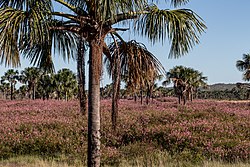Cerrado
The Cerrado (Portuguese pronunciation: [seˈʁadu]) is a vast ecoregion of tropical savanna in central Brazil, being present in the states of Goiás, Mato Grosso do Sul, Mato Grosso, Tocantins, Maranhão, Piauí, Bahia, Minas Gerais, São Paulo, Paraná and the Federal District.
[2] The second largest of Brazil's major habitat types, after the Amazonian rainforest, the Cerrado accounts for a full 21 percent of the country's land area (extending marginally into Paraguay and Bolivia).
[4] Vast amounts of research have shown that the Cerrado is one of the richest of all tropical savanna regions and has high levels of endemism.
[6][5] Between the cerrado and the gallery forest is an area of vegetation known as the wet campo with distinct up- and downslope borders where tree growth is inhibited due to wide seasonal fluctuations in the water table.
[5] The herbaceous layer usually reaches about 60 cm in height and is composed mainly of the Poaceae, Cyperaceae, Leguminosae, Compositae, Myrtaceae and Rubiaceae.
[5][9] The amount of potassium, nitrogen and phosphorus has been found to be positively correlated with tree trunk basal area in Cerrado habitats.
[5] Cerrado vegetation is believed to be ancient, stretching back perhaps as far in a prototypic form as the Cretaceous, before Africa and South America separated.
[12] These processes and the resulting fragmentation in multiple refugia have probably contributed to the high species richness both of the Cerrado and of the Amazonian rainforest.
[19] The crowned solitary eagle, hyacinth macaw, toco toucan, buff-necked ibis, dwarf tinamou, and Brazilian merganser are examples of birds found in the Cerrado.
[22] A yearlong survey of the Cerrado at one reserve in Brazil found that the orders Coleoptera, Hymenoptera, Diptera and Isoptera accounted for 89.5% of all captures.
[27] Taking advantage of the sprouting of the herbaceous stratum that follows a burning in the Cerrado, the aboriginal inhabitants of these regions learned to use the fire as a tool, to increase the fodder to offer to their domesticated animals.
Xavantes, Tapuias [pt], Karajás, Avá-Canoeiros, Krahôs, Xerentes, Xacriabás were some of the first indigenous peoples occupying different regions in the Cerrado.
Researchers also developed tropical varieties of soybeans, until then a temperate crop, and currently, Brazil is the world's main soyabeans exporter due to the boom in animal feed production caused by the global rise in meat demand.
[34] Large extensions of the Cerrado are also used for the production of cellulose pulp for the paper industry, with the cultivation of several species of eucalyptus and pines, but as a secondary activity.
The biome contains the headwaters and the largest portion of South American watersheds (the Paraná-Paraguay, Araguaia-Tocantins, and São Francisco river basins) and the upper catchments of large Amazon tributaries, such as the Xingu and Tapajós.
During the last four decades, the Cerrado’s river basins have been highly impacted by extreme deforestation, expansion of the agricultural and cattle ranching frontier, construction of dams, and extraction of water for irrigation.
[29] This industrial farming of the Cerrado, with the clearing of land for eucalyptus and soy plantations, has grown so much because of various forms of subsidy, including very generous tax incentives and low interest loans.
[41] There is also a strong agribusiness lobby in Brazil and in particular, the production of soybeans in the Cerrado is influenced by large corporations such as ADM, Cargill and Bunge, these latter two directly associated with the mass deforestation of this biome.
[29] Teams from the University of Brasília, CPAC and the Royal Botanic Garden Edinburgh have been collaborating on this project for a number of years supported by Brazilian, European Community and British funds.
The project has recently been expanded into a major Anglo-Brazilian initiative, Conservation and Management of the Biodiversity of the Cerrado Biome, with UK Overseas Development Administration funding.
Its aim is to survey the floristic patterns of Cerrado vegetation and to discover representative areas and biodiversity "hot-spots".
[44] IUCN Category III[48] Wildlife refuges protect natural environments to ensure the persistence and reproduction of species or communities of local flora and fauna.
[44] IUCN Category IV[48] Generally consisting of a small area, these units aim to preserve regionally or locally important ecosystems that have unique characteristics.
[44] IUCN Category VI[48] While publicly owned, traditional populations may occupy extractive reserves to support their lifestyle based on extractivism, subsistence farming and small animal husbandry.
Two conservation units in the Cerrado biome have been designated together as a UNESCO World Heritage Site: Chapada dos Veadeiros and Emas National Parks.
As National Parks, they are registered as integral protection units and benefit from strict regulations preventing the direct use of their resources.
[49] Concerns have been raised about the effectiveness of protected areas in the Cerrado given the small proportion of land they cover and their varying degrees of strictness.
Sustainable protection units, which are less strict as biodiversity conservation is not their primary goal, have been found to be ineffective against deforestation.
[55] Brazil’s Forest Code requires land owners to retain 20% of native vegetation as Legal Reserves on their properties in all biomes except the Amazon, where the number is 80%.
[55] Indigenous lands also effectively represent the ecosystem services and biodiversity characteristic of the Cerrado biome and are efficient in reducing habitat conversion and deforestation.




